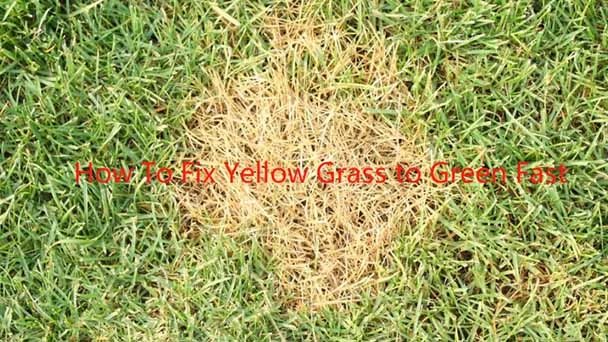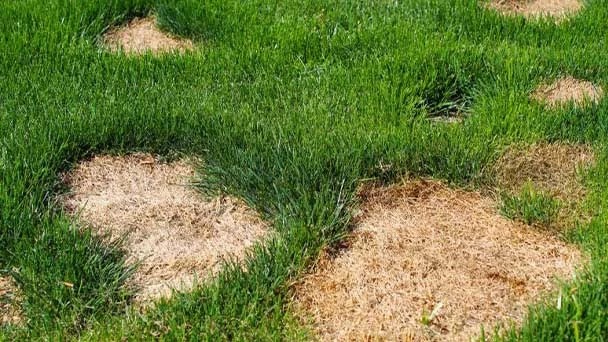How To Fix Yellow Grass to Green Fast - Ways & Tips
Written by Ivy
Dec 28 2022

A lush green lawn that has some yellow patches of grass is the worst. We'll examine the typical causes of yellowing of your lawn today, along with remedies.
Why is My Grass Turning Yellow and Dying?
If you've noticed yellow spots on your grass, chances are you're worried about the state of your lawn, and all sorts of things are running through your mind:
- My lawn looks awful!
- Did I permanently sabotage it?
- Is this the lawnmower I use?
- What did I do wrong?
- Is my grass dying because I used the wrong fertilizer or a product that kills it?"
Yellow spots can affect any type of grass, including perennial ryegrass, fine fescue, Kentucky bluegrass, buffalo grass, Bermuda grass, centipede grass, and even St. Augustine grass.
What then might be causing your lovely grass to turn color? Other than frost – a common cause of yellow grass – here are five of the most common reasons why your lawn could be losing its dark green color and turning yellow:
1. Prolonged Heat
Long periods of heat can cause your grass to dry out and lose its color; this is especially problematic in the summer.
The grass may begin to yellow in as little as a few days, depending on the temperature and type of grass you have. When temperatures are too high, your grass loses moisture, which is one of the factors that is essential to keeping it lush and green, and begins to turn yellow so you need to revive your dead grass.
2. Lawn Disease
Lawn disease is a second possible cause of yellowing grass. Fortunately, despite being fairly widespread, lawn diseases are simple to identify.
The worst grass diseases can affect both warm- and cool-season grasses.
Even the most well-maintained lawns can be unsafe and exposed. This is due to the fact that disease-causing fungi are constantly present in the soil, waiting for the right moment and circumstance to attack.
Learn to spot the symptoms so you can prevent and treat lawn diseases before they cause unimaginable damage to your grass.
3. Poor General Lawn Care
Although it's common to attribute yellowing grass to conditions like heat and lawn diseases, yellowing can also result from poor general lawn maintenance.
For instance, mowing too closely or neglecting your lawn can cause your grass to turn yellow.
Your grass will turn yellow if it is cut too short (near the ground). This happens when there is insufficient moisture in the grass. As it occurs shortly after mowing the lawn, you will frequently notice it.
4. Dog Spots
Does your lawn allow your dog(s) to run around?
Because the urine from your dog might be the cause of the yellowing of your lawn!
A high nitrogen content in dog poop causes grass to burn. The grass begins to burn, yellow patches appear, and before you know it, your grass is dying.
5. Grass Stress
Is your lawn under stress? There are several ways you could be stressing your grass, including:
- Over and under fertilizing: Nitrogen is a component of fertilizer, and too much of it can cause your grass to scab. Too little fertilizer can lead to nutrient deficiency, and grass lacking enough nutrition – especially iron and nitrogen, which play a vital role in the chlorophyll process – can turn yellow.
- Using excess pesticides: Your lawn can become scorched and develop yellow grass if pesticides and herbicides are used excessively.
- Overwatering:
Your grass's roots will not grow well if you overwater it. As a result of waterlogging, too much water reduces the amount of oxygen in the soil. Your grass's shallow roots will make it difficult for it to absorb nutrients, oxygen, and even water, which will eventually cause your lawn to turn yellow.
Due to decreased resistance, overwatering your lawn will also result in fungus diseases and insect infestation.
6. Nutrient Deficiency
A lawn with yellowing patches and stripes might be lacking in nutrients. If there are areas in your lawn where you miss applying fertilizer, you'll notice a faint yellow or fluorescent discoloration on the leaf blades while the rest of the grass shows signs of deep greening and thicker, faster growth.

Can Yellow Grass Turn Green Again?
The majority of the time, it is possible to quickly turn yellow grass green and restore your lawn to its former beauty.
In order to solve a problem, all you need to do is arm yourself with the proper knowledge about the problem's cause and potential solutions. Your lawn is once greener.
How Do You Make Yellow Grass Green Fast?
You now understand why your grass is turning yellow (thanks to the advice given above, ahem!), here's how to turn yellow grass green fast: (Also Read: How to Make Your Grass Green Fast & Naturally)
Water Your Grass Early in the Morning
This will lessen the amount of water that evaporation brought on by later in the day's intense heat. To avoid damaging your grass, be careful not to overwater it.
Prevent Lawn Diseases
You can solve a wide range of issues by feeding, watering, and properly cutting your grass. Treat lawn diseases as soon as you notice symptoms to turn grass yellow quickly if the damage has already been done.
Make Sure Your Mower Blades Are Sharp
When you use your lawnmower to cut your grass the next time, make sure the blades are sharp and set to the right cutting height. To turn yellow grass green, you should also improve the aeration and drainage of your lawn and maintain it properly.
Keep Pet Urine Off Your Lawn
Follow your friend in the yard, and after they've urinated, wash down the area with a neutralizer to prevent yellowing brought on by dog poop.
Alternately, you could teach your dog to go potty in a specific location (preferably one that is not covered in grass). If that doesn't work, you can reseed or resod your lawn to make yellowing grass green again.
Practice Proper Lawn Care
Follow the proper fertilizing schedule for your type of grass to fix yellowing caused by overfertilizing and under fertilizing.
Deep watering your lawn can also aid in removing surplus fertilizer from the soil and away from grass roots. So, kindly continue doing it for a few days until your grass resumes turning green.
Use Lawn Care Products According to the Directions
To avoid overusing pesticides and herbicides, follow the manufacturer's instructions regarding dosage and frequency.
Adjust Your Watering Routine
If your lawn needs water, only apply it. If there has been a lot of rain since you first noticed your grass turning yellow, you might want to temporarily stop watering before starting again.
- Just water your lawn when the top two inches of soil are no longer moist.
- Make sure to water in accordance with the maintenance schedule recommended for your specific grass.
- Most lawns benefit from being watered two to three times per week. Reduce the frequency to once or twice only if it results in yellow spots.
- Consider irrigating your lawn with less water than is advised for the type of grass there.
Different grass varieties call for various watering schedules. Yellowing St. Augustine grass may indicate a fungal infection and water logging.
To avoid this, seek advice on the best maintenance practices for St. from a local lawn care specialist. Augustine grass to eliminate the yellow spots on your lawn by altering the watering schedule.
Fertilize Your Lawn When Needed
It's a sign that you applied too much fertilizer when your grass turns yellow after fertilizing. By sluggishing your applications, you can fix this. As an alternative, you might want to use a good slow-release fertilizer, preferably one that is organic. Your lawn won't burn or develop yellow spots as a result.
- Purchase fertilizer with the appropriate NPK amounts after conducting a soil test to identify the lacking nutrient.
- Follow the instructions on the fertilizer label when applying it.
- Feeding your lawn in the right amounts will assist in restoring the green color of nutrient-deficient grass.
I always favor using organic fertilizers with a high nitrogen content. Even if you ignore the label instructions, they hardly ever burn your lawn.
Treat Lawn Diseases
Lawn diseases can cause symptoms on the blades like spotting and wilting and slow down the growth of your lawn. Treat any fungal infections or other diseases as soon as you notice symptoms to help yellow grass turn green more quickly.
The majority of lawn diseases are fungal infections brought on by moisture. Therefore, make sure you always have fungicides on hand, like DiseaseX, to treat diseases like brown patch, grey spot, and any others that are comparable.
Additionally, you might need to treat your lawn right after winter to get rid of any fungus that might have emerged during the frosty days. This will hasten the rapid regrowth of your lawn.
Conclusion
While it can be depressing to see your grass turn yellow and begin to die, there are ways to quickly turn that grass green. Your lawn could become lush green once more quickly with the right knowledge and some patience.
FAQs
Why is My Grass Turning Yellow in Summer
The most frequent cause of a lawn turning yellow or brown is a deficiency in the lawn that leads to the lawn becoming ill. The most common causes of lawns turning yellow or brown are lack of nutrients, such as nitrogen, or lack of water.
Why is My Grass Turning Yellow and Dying
The most frequent cause of a lawn turning brown or yellow is something missing from it, which makes the lawn ill. The most common causes of lawns turning yellow or brown are lack of nutrients, such as nitrogen, or lack of water.
How to Fix Yellow Grass from Dogs
After your dog has urinated, spray water on the area to help dilute the nitrogen in the urine and lessen damage to the lawn by preventing the grass and soil from absorbing too much nitrogen.
Latest Updated
- Benefits of Bugleweed - 7 Science-backed Health Benefits
- Bugleweed Dangers & Side Effects - Is It Poisonous?
- How to Plant Evergreen Trees - What You Should Know
- When to Plant Evergreens - Grow Guide for Evergreen Trees
- 12 Wonderful Evergreen Shrubs for Your Garden
- 12 Popular Evergreen Plants with Pictures for Beginners
- When And How To Prune A Lilac Bush Like a Pro
- How to Grow & Care for Lilac Vine (Hardenbergia Violacea)
- Japanese Lilac Tree (Syringa Reticulata) Care & Propagation Guide
- Shumard Oak Pros and Cons - What to Know
Popular Articles
- Winter maintenance of Antirrhinum Majus
- How to Grow Terminalia Mantaly Tree
- How to Grow and Care for Crossostephium Chinense
- How to grow Antirrhinum Majus in spring
- Peristeria Elata (Dove Orchid) Profile: Info & Care Guide
- Underwatered Snake Plant (Sansevieria Trifasciata) - Signs And How To Fix
- How to Care for Brazilian Jasmine Plant (Mandevilla Sanderi)
- How to Grow & Care for Graptopetalum Purple Delight in Summer
- Rosa Chinensis (China Rose): Plant Growing & Care Tips
- How to Care for Baby Sun Rose (Aptenia Cordifolia)